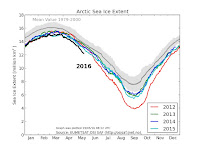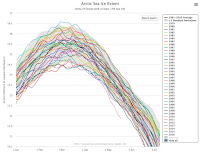 NSIDC’s Mark Serreze confirmed in an email that the 2016 Arctic sea ice extent is indeed at record-low levels for May, as implied by Figures 1 and 2. Different agencies use different algorithms to measure sea ice extent, but the slight variations that result do not affect the big picture.
NSIDC’s Mark Serreze confirmed in an email that the 2016 Arctic sea ice extent is indeed at record-low levels for May, as implied by Figures 1 and 2. Different agencies use different algorithms to measure sea ice extent, but the slight variations that result do not affect the big picture.This year’s hasty ice retreat has been fueled by incredibly mild temperatures across the Arctic during much of the winter and spring--a byproduct of El Niño atop longer-term warming from human-produced greenhouse gases. At Barrow, Alaska, every day since January 1 has been above average except for January 22, February 6, and a stretch from March 28 to April 3. Alaska’s Climate Division 1, which covers the North Slope, is having its warmest year to date by far, with the January-to-April average of 2.7°F beating the previous record (–1.4°F, from 2014) by an eye-popping 4.1°F. Another red-letter data point: snow cover disappeared from the open tundra at the NOAA Barrow Observatory on May 13. Assuming that no snow cover returns this spring--an increasingly good bet--this is the earliest melt-out date by far in 74 years of record keeping at the Barrow lab, beating out May 24, 2002. Conditions have also been exceptionally mild on the other side of the Arctic. The town of Longyearbyen in Svalbard, Norway--the northermost civilian community on the planet--has had only one below-average day in 2016 thus far.
Arctic Sea Ice Goes Far Beyond Record Low Extent for May

No comments:
Post a Comment